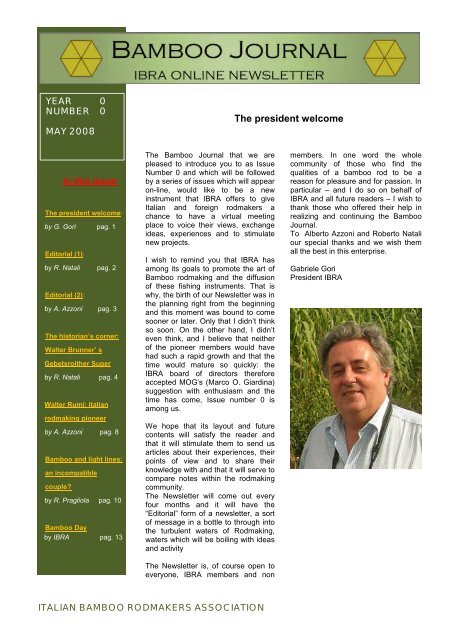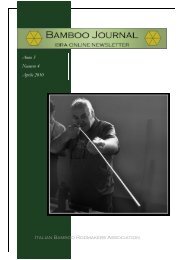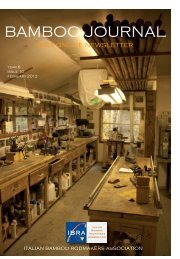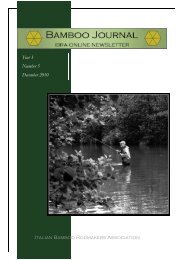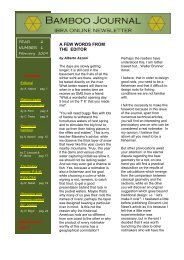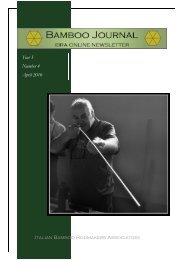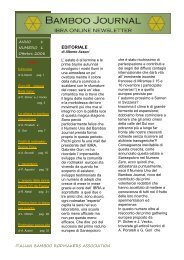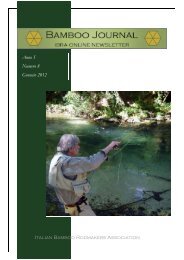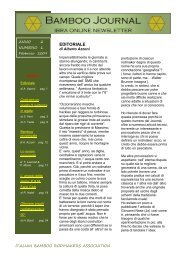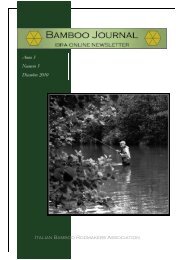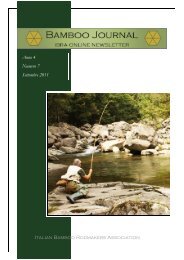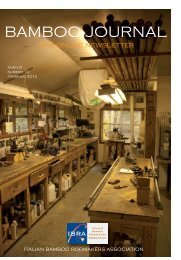The president welcome
The president welcome
The president welcome
You also want an ePaper? Increase the reach of your titles
YUMPU automatically turns print PDFs into web optimized ePapers that Google loves.
YEAR 0<br />
NUMBER 0<br />
MAY 2008<br />
<strong>The</strong> <strong>president</strong> <strong>welcome</strong><br />
In this issue:<br />
<strong>The</strong> <strong>president</strong> <strong>welcome</strong>:<br />
by G. Gori pag. 1<br />
Editorial (1):<br />
by R. Natali pag. 2<br />
Editorial (2):<br />
by A. Azzoni pag. 3<br />
<strong>The</strong> historian’s corner:<br />
Walter Brunner’s<br />
Gebetsroither Super<br />
by R. Natali pag. 4<br />
Walter Rumi: italian<br />
rodmaking pioneer<br />
by A. Azzoni pag. 8<br />
Bamboo and light lines:<br />
an incompatible<br />
couple?<br />
by R. Pragliola pag. 10<br />
Bamboo Day<br />
by IBRA pag. 13<br />
<strong>The</strong> Bamboo Journal that we are<br />
pleased to introduce you to as Issue<br />
Number 0 and which will be followed<br />
by a series of issues which will appear<br />
on-line, would like to be a new<br />
instrument that IBRA offers to give<br />
Italian and foreign rodmakers a<br />
chance to have a virtual meeting<br />
place to voice their views, exchange<br />
ideas, experiences and to stimulate<br />
new projects.<br />
I wish to remind you that IBRA has<br />
among its goals to promote the art of<br />
Bamboo rodmaking and the diffusion<br />
of these fishing instruments. That is<br />
why, the birth of our Newsletter was in<br />
the planning right from the beginning<br />
and this moment was bound to come<br />
sooner or later. Only that I didn’t think<br />
so soon. On the other hand, I didn’t<br />
even think, and I believe that neither<br />
of the pioneer members would have<br />
had such a rapid growth and that the<br />
time would mature so quickly: the<br />
IBRA board of directors therefore<br />
accepted MOG’s (Marco O. Giardina)<br />
suggestion with enthusiasm and the<br />
time has come, Issue number 0 is<br />
among us.<br />
We hope that its layout and future<br />
contents will satisfy the reader and<br />
that it will stimulate them to send us<br />
articles about their experiences, their<br />
points of view and to share their<br />
knowledge with and that it will serve to<br />
compare notes within the rodmaking<br />
community.<br />
<strong>The</strong> Newsletter will come out every<br />
four months and it will have the<br />
“Editorial” form of a newsletter, a sort<br />
of message in a bottle to through into<br />
the turbulent waters of Rodmaking,<br />
waters which will be boiling with ideas<br />
and activity<br />
<strong>The</strong> Newsletter is, of course open to<br />
everyone, IBRA members and non<br />
members. In one word the whole<br />
community of those who find the<br />
qualities of a bamboo rod to be a<br />
reason for pleasure and for passion. In<br />
particular – and I do so on behalf of<br />
IBRA and all future readers – I wish to<br />
thank those who offered their help in<br />
realizing and continuing the Bamboo<br />
Journal.<br />
To Alberto Azzoni and Roberto Natali<br />
our special thanks and we wish them<br />
all the best in this enterprise.<br />
Gabriele Gori<br />
President IBRA<br />
ITALIAN BAMBOO RODMAKERS ASSOCIATION
Bamboo Journal Page 2<br />
Editorial (1)<br />
When the President asked me to give Alberto Azzoni a<br />
hand in drawing up an IBRA newsletter, I was quite<br />
surprised and flattered and my first impulse was that to<br />
decline. I am one of the last people to join IBRA and as<br />
a Rodmaker I have only ever made my Number one<br />
during the last IBRA Rodmakers’class and so I felt that<br />
I should only read about Rodmaking rather than write<br />
about it. However when the President said “you can<br />
give us your contribution in its making and take care of<br />
the historical part of Rodmaking”, I accepted because,<br />
when five years ago I was lent a Pezon & Michel (8’6”<br />
Parabolic Normal) I was “struck” by bamboo and from<br />
then I’ve spent a small fortune (for my possibilities) in<br />
collecting European Bamboo rods (mainly) and some<br />
American ones too.<br />
Since I was faced with the need to do a lot of<br />
restoration work, I started collecting books on collecting<br />
and I started studying Rodmaking with extreme<br />
difficultly mainly because of my scarce knowledge of<br />
English and I eventually decided to attend the IBRA<br />
Rodmaking Class. So I do not consider myself an<br />
“expert” but rather a simple collector with a passion who<br />
get great pleasure from fishing with a rod made 50 - 70<br />
years ago: I use a Hardy Palakona (a mythical 8’5<br />
weight Phantom) made in 1957 (the year I was born<br />
in) that is in a lot better conditions than I am and often a<br />
7 ‘4 weight HI Prince which dates to the beginning of<br />
the 50’s. As a collector, I have surely got a few loose<br />
screws especially due to the fact that I recently won an<br />
auction for an 8’Hardy CC de France which is dated<br />
1910! Just think what it’s like fishing with a rod that is 98<br />
years old!<br />
My good friend Moreno says that once I start fishing<br />
with my own rods, I will be “healed”, but I have serious<br />
doubts. I hope my collaboration will serve IBRA and I<br />
hope the experts” (the real ones) will forgive my<br />
inaccuracy when I discuss the various Rodmakers and<br />
their work.<br />
I also hope that my articles on rods that have made<br />
history will be of interest to you and to further stimulate<br />
your interests, I will try to publish the taper of every rod<br />
I will discuss in case you were to decide to make one.<br />
Roberto Natali<br />
ITALIAN BAMBOO RODMAKERS ASSOCIATION
Page 3<br />
EDITORIAL (2)<br />
Bamboo Journal<br />
Bamboo Journal<br />
Dear Friends<br />
This is the first issue, the Number Zero”of “ <strong>The</strong><br />
Bamboo Journal “, a Newsletter that will be<br />
issued every 4 months and which will be available<br />
on the IBRA website and it can be downloaded<br />
directly to your computer. This project stems<br />
directly from an initiative by our untiring President<br />
– Gabriele Gori who last winter with an<br />
unexpected phone call, offered me the position of<br />
editor. So it was either the surprise of the offer or<br />
perhaps because on the spur of the moment I<br />
couldn’t find any plausible excuses to decline,<br />
also because the idea to have the opportunity of<br />
getting to know the small and big rodmakers’<br />
secrets first hand, made me accept willingly and I<br />
must admit I was quite honoured. Roberto Natali,<br />
whose greeting you will read later, will share this<br />
role with me.<br />
We belong to a relatively young community, most<br />
of us met for the first time three years ago in<br />
Sansepolcro and we have grown a lot. We have<br />
broaden our horizons and there will be new<br />
projects; we were only missing an official voice<br />
which would be to find by all and since the<br />
Internet offers this opportunity it would be a pity to<br />
not take advantage.<br />
I wrote that you will be able to find this magazine<br />
(or better still Newsletter) but the fact that it will<br />
exist depends exclusively on you: we are all part<br />
of the staff, the container is empty and we need to<br />
fill it up with our articles.<br />
What can we read/write on the Bamboo Journal? I<br />
don’t think you need my advice; perhaps we will<br />
not be so different to our mother/sister form<br />
overseas “Power Fibres” but if what J.D. Wagner<br />
wrote after the 2007 International German<br />
Rodmakers’Meeting: <strong>The</strong> Europeans are leading<br />
the way in inventive techniques and styles in their<br />
everyday work”, perhaps we do have something<br />
to talk about.<br />
In this issue, a part from Gabriele Gori’s greeting,<br />
a homage to Walter Rumi, one of the pioneer<br />
Italian rodmakers to whom quite a few of us owe<br />
something, then Roberto Pragliola’s ideas on<br />
bamboo and he knows something about casting –<br />
he is literally a Master Caster and finally an article<br />
about an historical rod made by an historical<br />
European Rodmaker – the Gebetsroither Super<br />
by Walter Brunner.<br />
Yes, the subject matter could be this one:<br />
important people in the Rodmaking world or fly<br />
fishers who have some connection to our beloved<br />
rods: descriptions of historical rods or at least<br />
interesting for some reason and above all articles<br />
on taper design and the construction of rods, tools<br />
or machines that clutter up our workshops. We will<br />
publish reports about gatherings, reviews about<br />
book and magazine that deal with Bamboo.<br />
<strong>The</strong> Newsletter will be published every quarter …<br />
if we have material and will be available in Italian<br />
and English. I invite you to not hesitate and to<br />
send us whatever you feel could be of interest; do<br />
not worry about it being commonplace, everyone<br />
remembers when at the beginning every small<br />
step forward cause perplexity. If, in your desk you<br />
have a small secret that will solve a small problem<br />
do not hesitate to make it known to someone who<br />
is looking just for that solution. If instead you’ve<br />
discovered the taper for the “ideal rod” bring it<br />
before the cruel justice of our world of<br />
perfectionists.<br />
<strong>The</strong> one thing that strikes me every time I meet<br />
the more expert rodmakers is how willing they are<br />
to share their knowledge and also the extreme<br />
ease with which they explain concepts and<br />
procedures that are apparently difficult. I hope to<br />
find in these pages the same communicative<br />
strength and the willingness to share experiences<br />
that has made every gathering a real enriching<br />
occasion both from a personal and a technical<br />
point of view.<br />
Send your articles in the language you prefer (we<br />
should be able to traslate the most common<br />
ones), possibly in a Word format to<br />
editor@rodmakers.it<br />
Alberto Azzoni<br />
ITALIAN BAMBOO RODMAKERS ASSOCIATION
Bamboo Journal Page 4<br />
“<strong>The</strong> Historian’s Corner”<br />
<strong>The</strong> Gebtsroither Super by Walter Brunner<br />
It’s not easy to start writing a column, let alone doing it in a Newsletter for Rodmakers! Just think how many<br />
famous Rodmakers and legendary rods have written the history of fly fishing, so much so that many modern<br />
Rodmakers are still using classical and time tested tapers by Payne, Dickerson, Garrison, Gillum, Leonard,<br />
etc.<br />
Even the modern Italian rodmakers have begun with famous tapers just as the modern American Rodmakers<br />
have done before them – Cattanach, Gould etc., this is also due to the fact that the literature which was<br />
available to the Italian pioneers was all American! In Europe there was however a Rodmaker whose fame<br />
and capacity was comparable with the great American Rodmakers: Walter Brunner.<br />
Brunner during the final phases of a catch when he suggest to turn<br />
the rod by 180° to compensate for the stress the rod has to undergo<br />
during the initial fight with a fish.<br />
” Glass case with some of Walter Brunner’s works<br />
of art at the ’Österreichische Fischereigesellschaft,<br />
gegr. 1880<br />
Walter Brunner (b. 2/04/1927 – d. 26/01/2007) was<br />
without doubt the greatest European Rodmakers,<br />
excluding the industries like Hardy and Pezon & Michel.<br />
He was also the only one to make rods continuously<br />
from 1963 to 2007! Another characteristic of Brunner’s<br />
production is that his first rods were developed in<br />
collaboration with great fly casters (the Austrian Hans<br />
Gebetsroither and the Swiss Hans Reiter Hebeisen )<br />
who theorized on a casting technique that was totally<br />
“different” to the classical English and American casting<br />
styles and which was based on short but powerful rods.<br />
ITALIAN BAMBOO RODMAKERS ASSOCIATION
Page 5<br />
Bamboo Journal<br />
Bamboo Journal<br />
Hans Gebetsroither, Heidi Hebeisen and<br />
HR Hebeisen<br />
Similar techniques are still taught in Switzerland by HR Hebeisen<br />
(Swiss Casting Club), who has been the world casting champion<br />
various times with a personal record of 62,73 metres (1969), in<br />
Austria by Hans Aigner (Erste Gebetsroither<br />
Fliegenfischerschule – Gebetsroither School of Fly Fishing) and<br />
by Roman Moser (Roman Moser Casting-Clinic).<br />
History tells us that Walter Brunner became interested in fly<br />
fishing after the Second World War and built all his own<br />
equipment to make his first fly rods, having acquired the passion<br />
when he met an English fly fisherman on the Traun in 1949.<br />
After years of experimentation and the discovery of heat<br />
treatment, in 1961 he met Hans Gebetsroither who was struck by<br />
the quality of his rods and two years later, after the death of his<br />
boss, decided to dedicate his life totally to rodmaking and<br />
founded the company “Brunner-Austria Fliegenruten”. In 1964 his<br />
production had reached 100 pieces per year and much of the work is carried out on machines he made<br />
himself. Later on the use of machinery was reduced in order to achieve greater quality and at the end of the<br />
90’s, the production was around 50-60 rods a year..<br />
Brunner splitting a culm next to a 60° beveller built in 1964 and<br />
during node treatment.<br />
<strong>The</strong> collaboration with Hans Gebetsroither was<br />
fundamental for his first series of rods which was<br />
called “Wildwasser” and which consisted in models<br />
which remained in his catalogue for his whole<br />
rodmaking life: Cheri, Gebetsroither, Gebetsroither<br />
Super, Traun e Traun Spezial. <strong>The</strong> rods in this series<br />
are characterized by a very fast action, and they can<br />
be distinguished well for having the butt section<br />
length different to the tip section; they have black<br />
wrappings with either an all cork reel seat with black<br />
hardware or a cork handle with black screw locking<br />
reel seat. <strong>The</strong>y normally came with one tip, a green<br />
rod sock with a label that bore the rod details and a black rod tube with leather latches.<br />
<strong>The</strong> rod I will describe is the Gebetsroither Super, a “stiff pole” 2,00 metres long (Brunner rods are European<br />
and they were measured in metric) for 5/6 weight. This is one of the famous rods which were developed in<br />
collaboration with the famous Traun river keeper and you can understand it’s action only when you think<br />
about that river, its width, the immense flow of water and its great fish (at least until it remained one of the<br />
ITALIAN BAMBOO RODMAKERS ASSOCIATION
Bamboo Journal Page 6<br />
great rivers of the world). Many times, when Roberto Pragliola used to say that Bamboo was no good for his<br />
TLT style of casting, I would think “you have never tried a Gebetsroither Super” but then the IRP ( IBRA<br />
PRAGLIOLA rod) was born and when I tried it I thought “ it’s slower than a Gebetsroither Super”, but I’m not<br />
a good caster so consider these “as the impressions of a bad caster”. <strong>The</strong> rod was made continuously<br />
between 1963 to 2007 – for 44 years and it is the easiest Brunner rod<br />
to find with prices that go from €700 to €1.200 according to the<br />
conditions and on whether it has one or two tips (rare because these<br />
were only made to order). At least two versions were made and they<br />
are distinguishable by a different reel seat, either all cork with a weight<br />
of 85 grams or with screw locking reel seat which weighs 105 grams.<br />
<strong>The</strong> rods are hand signed in black ink with the name “Brunner –<br />
Austria” “Type<br />
Gebetsroither<br />
Super” “ 2,00m”<br />
and “85 g.” or<br />
“105 g ”. Each<br />
rod also has a<br />
code composed<br />
of the month and year and often a progressive number of the rod: e.g. if<br />
you find 572/54 written, this means that it is rod number 54 made in<br />
May of 1972; if you find written 12/80, the rod was made in December<br />
of 1980. <strong>The</strong> code if often written under the<br />
A “Wildwasser “ rod with tube and label<br />
main signature or above the hook keeper<br />
or more often in front of the handle<br />
between the two wrappings of the hook<br />
keeper. <strong>The</strong> ferrules have been browned and the wrapping made with black<br />
Gudebrod nylon with double wrapping on the curve of the guides<br />
(like Pezon & Michel, you may note the bulge in the photo), the<br />
stripping guide and tip top are in hard chromium and 6 snake guides but I do<br />
not know who supplied these. <strong>The</strong> rods are hand varnished and the quality<br />
is impeccable. On the whole it is a simple and elegant rod and I hope it has<br />
stimulated your fantasy.<br />
Brunner used a mill because he declared that in this way he could guarantee<br />
a more uniform and precise production, so I have no knowledge about what<br />
method he used to design his models; the taper I have attached was<br />
measured directly on a rod I own (a 1971 version with the screw locking seat)<br />
directly on the classical planing form stations and averaging the<br />
measurements obtained on the faces and they include the varnish. <strong>The</strong><br />
sections are quite precise. I inserted the data in RodDna to get the dimension<br />
chart and the stress curve.<br />
ITALIAN BAMBOO RODMAKERS ASSOCIATION
<strong>The</strong> results confirm the precision of the taper which was obtained using a mechanical mill.<br />
Roberto Natali<br />
River Traun ( Austria ) where Brunner’s Gebetsroither Super was born<br />
Le fotografie di questo articolo sono tratte da:<br />
http://www.freundedergmundnertraun.at/ - cataloghi Brunner - sito web OIFG 1883 - sito web Hebeisen<br />
ITALIAN BAMBOO RODMAKERS ASSOCIATION
Bamboo Journal Page 8<br />
Walter Rumi: Italian rodmaking pioneer<br />
every nook and cranny and one gets the urge to explore<br />
all the recesses to discover a secret.<br />
A. Azzoni interviewing W. Rumi<br />
<strong>The</strong> history of Italian rodmaking is quite recent: in 1977<br />
the book by Garrison & Carmichael came out; it created<br />
a real epidemic in the US while in Europe it stirred only<br />
a small number of rodmakers. Only in recent years we<br />
can say that the activity of the second and more<br />
numerous generation of rodmakers has originated from<br />
this small group of Pioneers. Walter Rumi belongs to<br />
this small group of first generation rodmakers. I met him<br />
recently at his home in the countryside near Brescia<br />
during a meeting for the organisation of the European<br />
Gathering which this year will take place in Sansepolcro<br />
(Arezzo).<br />
His workshop is the perfect setting, just what a novice<br />
rodmaker approaching this strange passion for the first<br />
time, would imagine – it is a classical basement or<br />
cellar just like one reads about in all the books on<br />
rodmaking. In fact it is a cellar with all the gloom,<br />
humidity and limited space with some kind of instrument<br />
in every corner.<br />
<strong>The</strong> selfmade binder and beveller<br />
Most of his tools are self made and so are all the Rod<br />
components; from the reel seat to the Nickel Silver<br />
ferrules. ( By the way Walter can have some excellent<br />
planing forms made to order )<br />
N/S ferrules<br />
Reel seats<br />
<strong>The</strong> lathe<br />
I’ve always envied those who can find their way around<br />
organised chaos and I believe that Walter is a living<br />
example: planing form, binder, lathe and so on occupy<br />
ITALIAN BAMBOO RODMAKERS ASSOCIATION
Page 9<br />
His favourite waters are those of the Chiese stream<br />
which goes through his village, then the Adige, the<br />
Fibbio and then those in Yugoslavia during the “August<br />
holidays”. Walter is a down to earth person and the<br />
ease with which he describes his work, makes it seem<br />
almost easy but we know that is not exactly so.<br />
Simplicity serving functionality<br />
He started his activity in the 70’s (he had been a<br />
tournement fisherman at his Club called “Il Cefalo” di<br />
Mazzano”) after having met another pioneer rodmaker<br />
Cosimo Raia on a river. With difficulty he gathered all<br />
the information he could (internet was not available)<br />
and with “<strong>The</strong> Bible” on his desk he made the first<br />
instruments and then the first rods with the historical<br />
American Tapers: Garrison to start off with. His<br />
favourite makers in the beginning were the classical:<br />
Gyllum, Payne, Leonard e T&T and among the Italian<br />
colleagues G. Nese, E. Scapin, M. Boretti. <strong>The</strong> next<br />
step was inevitably the search for his own tapers, using<br />
graphpaper at first then Hexrod later: his first tapers are<br />
for very fast rods. “often really stiff poles”, then the<br />
tendency went towards slower actions.<br />
Bamboo Journal<br />
Bamboo Journal<br />
It is strange, I don’t know if this has happened to you<br />
too, in the beginning we tend to look for graphite like<br />
actions e then we discover that the virtues of wood are<br />
others. Walter says, ” the action I prefer today is a<br />
progressive one because I feel that a rod must be a<br />
pleasant instrument to use and at the same time help<br />
you with casting. Fly fishing is a very personal pleasure:<br />
sometimes I will sit on a riverbank to watch the water<br />
flowing by until I see a fish rising while with other<br />
fishermen it looks like a competition to catch the most<br />
fish”.<br />
<strong>The</strong> secret to get a good rod? Simple, as I’ve just said,<br />
first of all a design project which comes from all the<br />
experience obtained from repeated trials and<br />
confrontation which helps to read graphs both stress<br />
curves and dimension charts, to understanding the<br />
quality of bamboo i.e. the density of the fibres, the heat<br />
treatment and the best glues. Furthermore Walter give<br />
great importance to the straightening the strips which<br />
have just been glued: straightening a rod at a later<br />
stage never gives a good result because sooner or later<br />
the initial bends tend to come out again. Just like their<br />
maker, Walter’s rods are sober, essential but they do<br />
not lack attention to detail but above all they are made<br />
to be used with convinction.<br />
One of the last creations<br />
If at it often happens, someone accuses you of<br />
belonging to a slightly snobbish world which is made up<br />
of nostalgia for a moment when looks and shiny things<br />
counted more than functionality, introduce them to<br />
Walter Rumi: no one better will be able to convince<br />
them that fishing with a bamboo rod doesn’t make you<br />
more handsome or elegant, but you will feel closer to<br />
nature.<br />
Alberto Azzoni<br />
Classic and armonized colours<br />
ITALIAN BAMBOO RODMAKERS ASSOCIATION
Bamboo and light lines: an incompatible couple?<br />
Light equipment has always been around. In fact we<br />
have felt this kind of need right from the beginning or<br />
almost. Unfortunately neither with bamboo yesterday<br />
nor with graphite today do we get efficient instruments.<br />
this I’ve been writing about and repeating for thirty<br />
years. No surprise therefore if fishermen consider them<br />
as being alternative instruments, to be used every now<br />
and then, perhaps when faced with a particular situation<br />
or even just for the fun. This, in a few words is the<br />
scenario. This is not a modern problem, since we have<br />
been dragging it with us since the bamboo period –<br />
more or less forever!<br />
<strong>The</strong> master of speed among the puzzled lazy men of the wood<br />
A rod can be compared to a spring, an instrument which<br />
is able to gather energy and then to release it after<br />
flexing. Now there are various types of springs: weaker<br />
ones, more powerful ones, it is evident that each one<br />
will release it proportionally. Taking this into<br />
consideration, a rod designed to cast for example a<br />
three weight line will correspond to a thinner spring i.e.<br />
an instrument which cannot place a fly further than a<br />
certain distance (usually a modest distance because<br />
the ratio weight projected / structure of the instrument<br />
will not allow for more), it will not cast flies which are<br />
bigger than a certain size. It is no coincidence, therefore<br />
that these rods are classified as midge rods. <strong>The</strong>y will<br />
not penetrate the wind (the excessive compliancy does<br />
not allow for enough speed) and finally it will not be able<br />
to contrast a larger fish. So this instrument is suitable<br />
for everything except casting and fishing efficiently. <strong>The</strong><br />
problem with these rods, their inefficiency and the origin<br />
of their limits is that they’ve been designed considering<br />
the weight they need to cast ( if a rod as a spring) and<br />
Talking of which, let’s examine the connection with what<br />
I’ve just said. Many ascertain that a bamboo rod will not<br />
tolerate any line weight under a #4, that this is a precise<br />
limit. Others feel that they can cast lighter lines only if<br />
the instrument is very flexible – just like the bamboo<br />
rods of the past and the modern graphite rods. However<br />
the former argue that this fact actually proves their<br />
point. A second controversial point is the rapidity, this is<br />
also considered as a negative prerogative of rods<br />
conceived for heavier loads than those we are<br />
discussing and for the same reasons these rods are<br />
alienated. This, in brief is the situation.<br />
Bamboo ferrules of the rod born fron R. Pragliola and I.B.R.A<br />
collaboration<br />
ITALIAN BAMBOO RODMAKERS ASSOCIATION
Page 11<br />
This was the challenge IBRA launched me which I<br />
accepted and together we completed it. Others will talk<br />
about the construction method of this rod.<br />
Bamboo Journal<br />
Bamboo Journal<br />
As far as my competence goes (the design), I can say<br />
that with a few and well chosen tricks taken directly<br />
from TLT* have given a rod which can cast a three<br />
weight, it is fast (proportionally fact for bamboo and to a<br />
couple of requisites which I will discuss later), it has a<br />
good feel and at the same time it can even handle big<br />
fish. This is not a minor factor. This rod is the answer to<br />
those who declare that this material does not tolerate a<br />
line under a four weight. Never say never! Also<br />
because, it is commonly known, these limits are not<br />
objective but personal. To confirm the intellectual<br />
prowess of IBRA, I can anticipate that we are working<br />
on other interesting projects and this will not be an<br />
isolated case.<br />
Now a few words about the use of this rod and which is<br />
not special in any way. You do not require particular<br />
characteristics to cast this rod – anyone can do so as<br />
was my and IBRA’s intentions. <strong>The</strong> right choice of line is<br />
instead very important. As I wrote a few years back, it is<br />
useless to declare that a certain rod casts a certain<br />
weight as we have always done. This is too generic. A<br />
part form the fact that there is often a big difference<br />
between the same weight lines but of different brands, I<br />
wrote in the past that the choice depends on what we<br />
are specifically looking for. For example, I like speed<br />
and I therefore use a DT 3# Ultra 4 line by 3M. Others<br />
prefer a more “plastic” use of the rod (which makes<br />
casting easier) and in this case I suggest a Aircel<br />
Supreme II DT 3.<br />
<strong>The</strong> Pragliola / I.B.R.A.: 7’2 ’# 3<br />
Before ending, allow me with 40 years of fly fishing<br />
experience, even if I cannot say I saw the birth of fly<br />
fishing in Italy, I have most certainly seen it’s evolution<br />
that I lived through its embryonic stages to its mass<br />
diffusion, to open a chapter on behalf of these IBRA<br />
guys. I have never hidden my pessimism regarding the<br />
modern evolution of fly fishing in our country: too much<br />
nonchalance! Well these guys, even though they are<br />
not the only ones, are the very expression of fly fishing.<br />
<strong>The</strong>y are, you can say, its “antibodies” and therefore<br />
they demonstrate the true essence of this kind of<br />
fishing. Those who try to run them down should think<br />
ITALIAN BAMBOO RODMAKERS ASSOCIATION
about this twice. It isn’t the manual action, but the spirit<br />
behind it that counts. Not a tangible fact it’s the great<br />
passion that inspires and unites them.<br />
fishing has no future. It just becomes another<br />
commonplace and useless way of catching fish.<br />
(Note: TLT = Total Casting Technique developed by<br />
Roberto Pragliola)<br />
Roberto Pragliola<br />
R. Pragliola between the souls of I.B.R.A.: G.Gori (right) and A.<br />
Poratelli (left)<br />
Bamboo and fast waters: an engaging challange<br />
European Bamboo Rodmakers Gathering<br />
ITALIAN BAMBOO RODMAKERS ASSOCIATION
Page 13<br />
Sansepolcro 23/24/25 maggio 2008<br />
Bamboo Journal<br />
Bamboo Journal<br />
BAMBOO DAY<br />
ITALIAN BAMBOO RODMAKERS ASSOCIATION
Bamboo Journal<br />
Italian Bamboo<br />
Rodmakers<br />
Association<br />
c/o Podere Violino<br />
Località Gricignano 90<br />
Sansepolcro (AR)<br />
Italy<br />
ibra@rodmakers.it<br />
§<br />
redazione<br />
Bamboo Journal<br />
editor@rodmakers.it<br />
§<br />
Press Office<br />
press@rodmakers.it<br />
§<br />
gruppi acquisti<br />
gruppiacquisti@rodmakers.it<br />
http://www.rodmakers.it<br />
ITALIAN BAMBOO RODMAKERS ASSOCIATION


